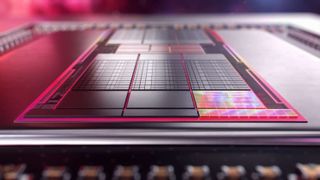Nick Evanson, {Hardware} author
This month I have been testing: A small mountain of ergonomic keyboards. Some aren’t particularly ergo in any respect, whereas others sit in a specialised area of interest all to themselves. I actually love the strange ones, even when it does really feel like studying the way to sort yet again.
I have been following the occasions of the CES for the reason that mid-Nineties and there is at all times one thing that stands out or sticks in your reminiscence. Take the 2005 occasion, when Microsoft tried to display the total talents of the Xbox 360 and failed somewhat miserably, or the 2011 one, the place 3DTVs have been being hyped as the way forward for leisure. Yeah, kinda bought that one mistaken. For this 12 months’s occasion, the largest factor that I seen, apart from AI being plastered onto completely all the pieces, was the entire lack of recent gaming laptops utilizing a discrete AMD Radeon chip. As in none, zip, zero, nada.
If I am trustworthy, I do not know what is going on on with AMD’s graphics division however I’m satisfied of 1 factor: It isn’t all in favour of massively increasing it. Certain, its income stream has been the steadiest of the 4 sectors (shopper, information middle, gaming, and embedded) for the reason that firm restructured its divisions in 2021. It makes a gentle revenue, too, whereas the others are in all places.
However that is fully right down to AMD supplying the APU that powers each PlayStation and Xbox on the market. Whereas Microsoft and Sony promote their consoles for nearly no revenue, AMD actually does not relating to its chips. So you’ll be able to’t depend on the monetary outcomes of the gaming sector to find out how nicely its graphics division is doing.
As an alternative, you simply have to take a look at how fashionable its merchandise are, and excluding the customized processors for consoles and the Steam Deck, you are taking a look at Radeon graphics playing cards and discrete laptop computer chips. The previous are nicely obtained as a result of they’re quick they usually’re loads cheaper than the competitors. Certain, they do not supply nifty AI options nor are they top-notch relating to ray tracing, however they’re advantageous for all the pieces else.
Figuring out precisely how fashionable Radeons are is not one thing a mere mortal resembling myself can do. Like everybody else, I’ve to depend on experiences from market analysts, resembling Jon Peddie Analysis, and figures from Steam’s {hardware} surveys. Averaging the previous 5 months of the latter’s findings, AMD’s graphics chips account for simply 10.1% of all of the GPUs recorded, and earlier than anybody thinks it varies loads, the usual deviation was simply 1.5%.
Jon Peddie’s findings paint a rosier image, with AMD holding 17% of the GPU add-in board market throughout Q2 and Q3 of 2023. That is not nice but it surely’s loads higher than 10%, that is for positive.
However that is for graphics playing cards and the considered attempting to dig via the entire obtainable information, simply to glean what the story is for discrete laptop computer GPUs is much too gloomy a prospect. So as an alternative, let’s simply take inventory of all the brand new gaming laptops introduced at CES 2024 that had an AMD Radeon, as an alternative of an Nvidia GeForce, for graphics duties.
There. Executed.
Yep, that is proper: There was none. Or if there was, it actually wasn’t from Asus, Acer, Alienware, Razer, MSI, Gigabyte, Lenovo, or any of the principle gaming laptop computer producers. How on Earth can that probably occur? If one transfers the recognition of Radeon playing cards throughout to the cell sector, you’d anticipate to see a minimum of a number of right here and there.
However for some cause, no person is utilizing them. AMD’s CPUs and APUs, completely, however simply not its GPUs. Let’s examine if we will work out why.
To start with, take into consideration what a laptop computer designer needs from a discrete GPU. It must be as small as doable, use as little energy as doable, keep efficiency even when clocked down low, and assist the entire newest graphics know-how. Area is a premium inside a laptop computer, as is energy as a result of the latter finally all converts into warmth.
A small, power-sipping chip does not require a big cooling resolution, making it area environment friendly and cheaper to fabricate the entire laptop computer.
AMD has 5 laptop computer fashions, primarily based on its RDNA 3 structure, with the range-topping Radeon RX 7900M sporting 72 Compute Items (CU), 64MB of L3 cache, and 16GB of GDDR6. It additionally has an influence restrict of as much as 180W. It makes use of the identical Navi 31 GPU as discovered within the Radeon RX 7900 sequence, albeit with a number of shaders disabled.
Sadly, there is no getting round the truth that it is a large chip (nicely, chiplets). At 529 sq. millimetres in whole, it takes up 40% extra space than Nvidia’s GeForce RTX 4090 Cell (which makes use of the AD103, the identical GPU within the RTX 4080 graphics card). That has a typical energy restrict of 150W, though it may be set larger by laptop computer distributors.
So AMD’s finest cell gaming GPU is larger and doubtlessly extra power-hungry than Nvidia’s, and though we have not examined it (just because we won’t!), I can not see performing as nicely, because it has fewer shaders they usually’re clocked slower. It is subsequently not too onerous to see why the RX 7900M is just not being utilized in any of the most recent gaming laptops.
However what concerning the different fashions, the Radeon RX 7600M, 7700S, and 7600S? Once more, no laptop computer maker seems to be all in favour of these, and I believe the explanations are the identical as for the 7900M: Not sufficiently small, not energy environment friendly sufficient, not quick sufficient.
And there is the truth that Nvidia dominates the discrete graphics card market, too. Laptop computer distributors will naturally wish to produce a gaming-focused mannequin that matches the shopper’s total consciousness of the GeForce model and outdoors of the fanatic sector, that is all that anybody talks about.
I’ve misplaced rely of the variety of folks I’ve spoken to about AMD and Radeon, solely to be met by glazed expressions. However point out GeForce and also you’re immediately understood.
AMD has the ultra-portable gaming sector virtually fully to itself, with the overwhelming majority of handheld PCs sporting one of many crimson staff’s APUs. The one handheld product of word powered by Nvidia is the Nintendo Change. Why is AMD the best choice right here? Simple, the chips are small, quick, use little or no energy, and supply precisely the correct quantity of efficiency wanted for such units.
So clearly AMD has the know-how and sources to make an ideal cell GPU, simply not one which sits by itself in a laptop computer, somewhat than being embedded in an APU. Gaming laptops aren’t a distinct segment product neither is AMD missing the cash required to make a concerted effort to battle Intel and Nvidia head-on in that sector.
To be blunt, I am getting a bit uninterested in studying how AMD’s subsequent GPU structure will change all the pieces round or the following Radeon would be the one to beat Nvidia. I do not suppose it issues, because it already has the mandatory know-how, as evidenced by the capabilities of the most recent consoles and handheld PCs.
What all of it comes right down to is cash, in fact. AMD is not averse to spending a number of billion {dollars} when it sees the potential in one thing (e.g. the acquisition of FPGA masters Xilinx) however I believe it simply appears to be like at its gaming division, sees the great income stream from the consoles, and solely needs to place sufficient effort into creating GPU architectures which can be finest fitted to information middle monsters, APUs, and different customized initiatives.
At instances, graphics playing cards and discrete laptop computer chips simply appear to be a helpful by-product of all of it, not a main focus for AMD’s gaming sector. However for the sake of competitors and hauling Nvidia’s sticky mitts off the GPU income fountain, I actually do want AMD would do one thing about all of it.
Besides it will not, in fact. It’s a enterprise, in spite of everything, and has a duty to its shareholders to make sure it invests its sources properly, so it’s going to solely make selections primarily based fully on sustaining its monetary establishment, on the very least. Why rock the boat, when the great ship HMS Gaming Division is chugging alongside properly?
It actually works nicely for AMD, simply not a lot for us PC players, particularly those that love a very good gaming laptop computer.

















